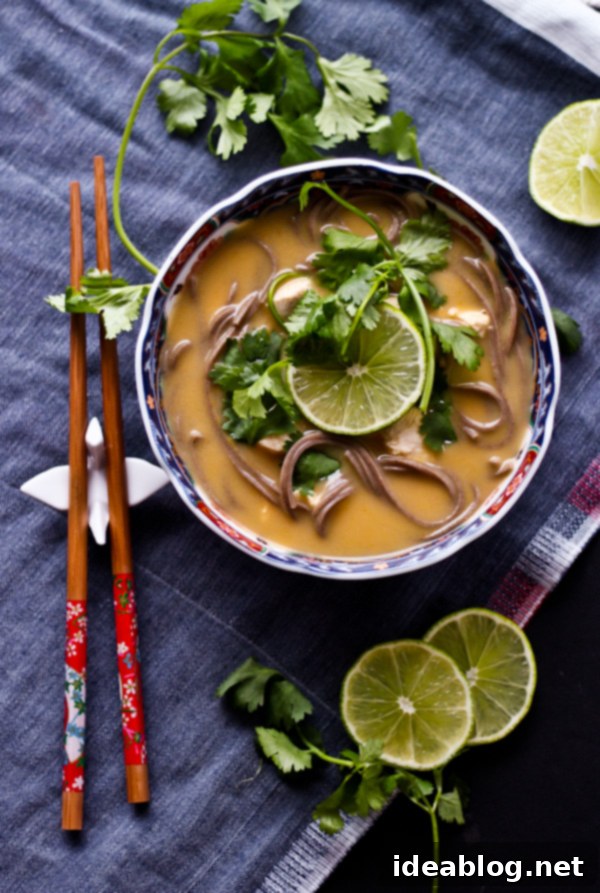Authentic Thai Coconut Chicken Noodle Soup: Aromatic & Comforting Homemade Recipe
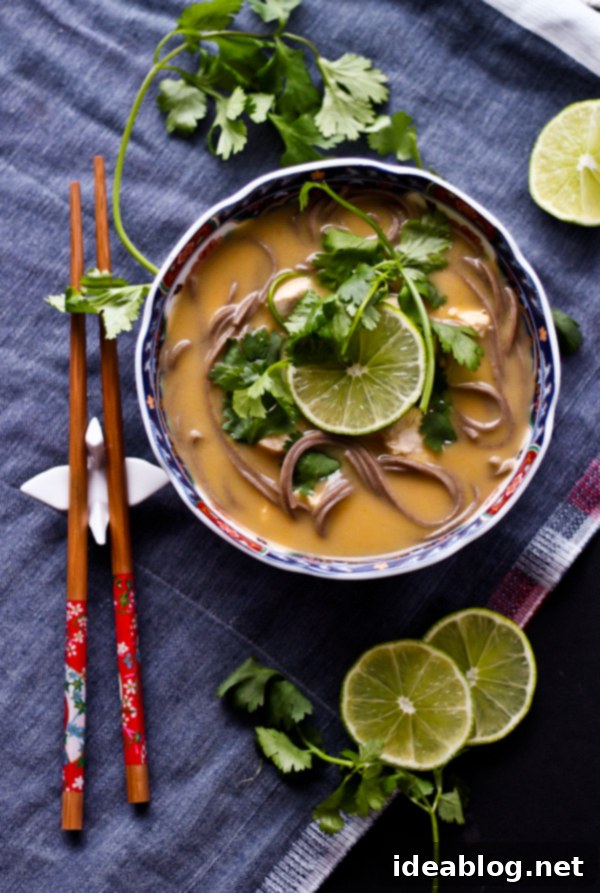
There are few culinary experiences as inviting and comforting as a steaming bowl of homemade Thai Coconut Chicken Noodle Soup. From the moment the first aroma wafts through your kitchen, you’re transported to a vibrant, exotic land. This delightful soup is a symphony of flavors, where the warmth of spicy ginger, the richness of coconut milk, the bright zest of kaffir lime leaves, and the savory depth of fish sauce dance together in perfect harmony. Enhanced with aromatic red curry paste and the distinctive kick of galangal, then finished with a squeeze of fresh lime juice and a generous topping of fresh cilantro, every spoonful is an unforgettable journey for your taste buds.
At the heart of this Thai Coconut Chicken Noodle Soup recipe lies its incredibly rich and deeply infused broth. It’s not just a base; it’s the very soul of the soup, meticulously crafted to carry all the complex, layered flavors that define truly exceptional Thai cuisine. This broth is where all the magic happens, slowly simmering to extract every ounce of fragrance and taste from the fresh aromatics.
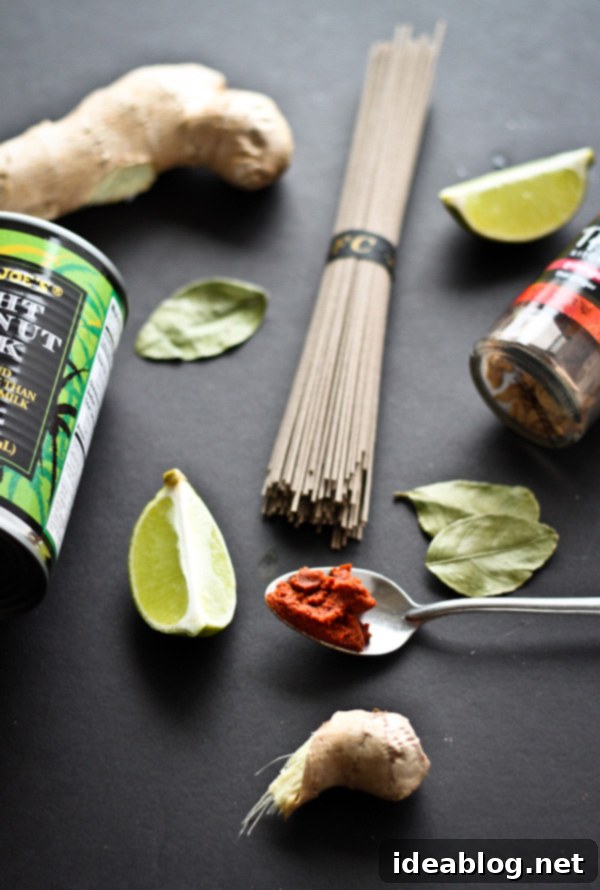
The inspiration for this particular rendition of Thai Coconut Chicken Noodle Soup was sparked by a memorable visit to a fantastic Thai restaurant in Washington D.C. over the Christmas holidays. That experience ignited a desire to recreate those authentic, soul-satisfying Thai flavors right in my own kitchen. While many traditional Thai soups can seem daunting, I wanted to develop a recipe that was accessible for home cooks, allowing everyone to enjoy these incredible tastes without requiring a passport or a culinary degree. The result is a comforting and aromatic soup that captures the essence of Thai cooking with a simplified approach.
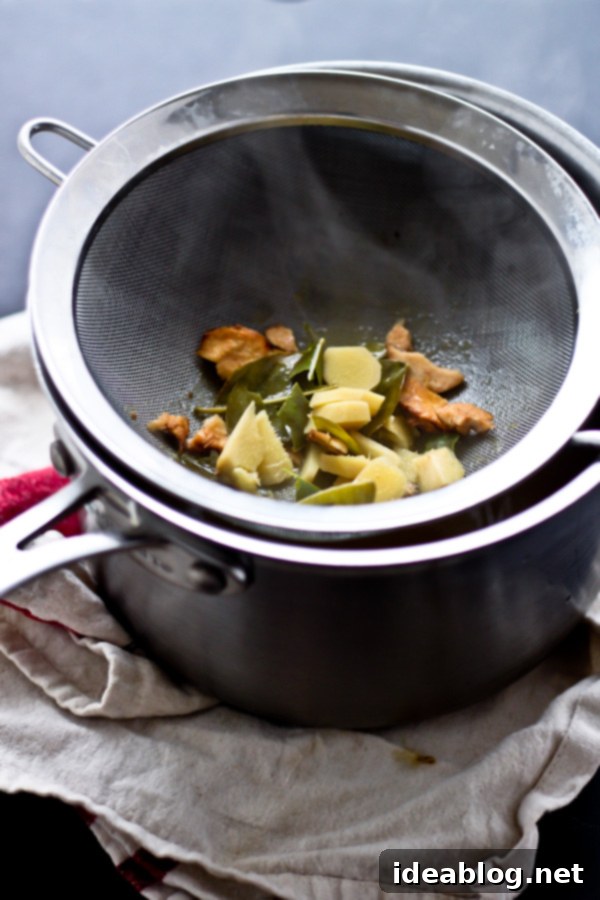
It’s important to clarify that this recipe is a very, very loose interpretation of the classic Thai soup known as Tom Kha Gai (Thai Coconut Chicken Soup). I cannot emphasize the words “loose” and “roughly inspired” enough. This is by no means a traditional, authentic Tom Kha Gai, which typically features ingredients like lemongrass, straw mushrooms, and a more specific balance of sweet, sour, salty, and spicy notes. My aim was to capture the comforting and aromatic qualities of a Thai-style coconut chicken soup, making it achievable for the home cook while delivering a profoundly satisfying flavor profile. Think of it as a delicious homage, designed to evoke the spirit of Thai cuisine with ingredients that are generally easier to source and a method that streamlines the cooking process. While it deviates from strict tradition, it offers a wonderfully rich and flavorful experience that will undoubtedly become a favorite in your recipe repertoire.
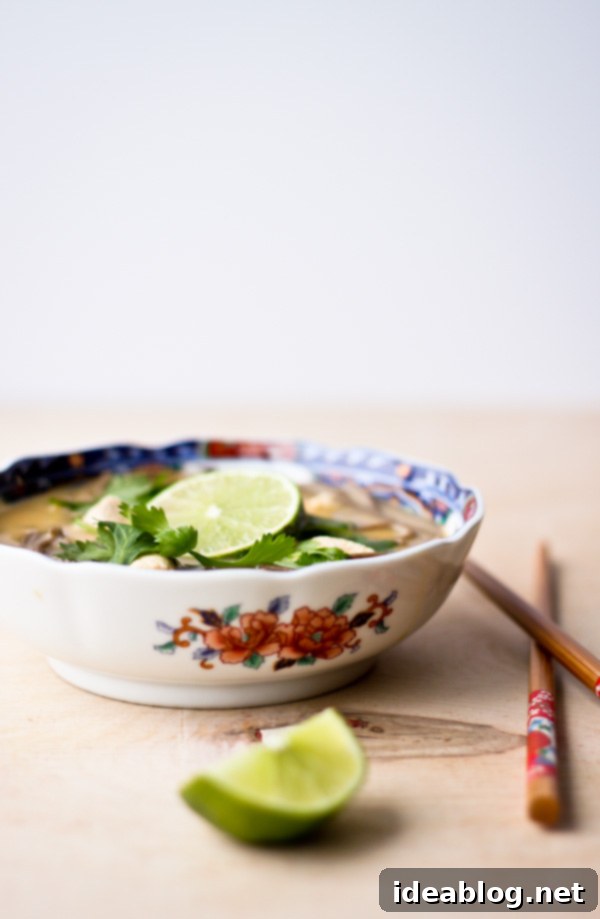
Essential Ingredients for Unforgettable Flavor
Given the relatively streamlined list of ingredients for this soup, I cannot stress enough the importance of not substituting or omitting any of them. Each component plays a crucial role in building the complex and authentic flavor profile. Sourcing high-quality, fresh ingredients will truly elevate your final dish from good to exceptional. Here’s a closer look at the key players:
The Aromatic Roots: Ginger and Galangal
- Fresh Ginger: This common root provides a spicy, warm, and pungent flavor that is fundamental to many Asian dishes. In this soup, it infuses the broth with a vibrant zing and a gentle heat that awakens the palate. Opt for fresh, firm ginger with smooth skin for the best flavor.
- Galangal Root: Often confused with ginger, galangal is its more citrusy, piney, and sharper cousin. It’s absolutely indispensable for achieving that distinct Thai aroma and taste. While fresh galangal is ideal, dried slices or powdered galangal can be used if fresh is unavailable. Look for fresh galangal in Asian supermarkets; some specialty grocery stores like Whole Foods may also carry it. Its unique flavor cannot be replicated by ginger alone, making it a critical ingredient for this soup.
The Citrusy Zing: Kaffir Lime Leaves
Kaffir lime leaves are a powerhouse of aromatic flavor, imparting a bright, floral, and intensely citrusy note that is unique to Southeast Asian cuisine. These distinctively shaped leaves release their essential oils when gently bruised or torn, creating an incredibly fragrant broth. They are not merely a garnish; they are a fundamental flavor builder. Fresh kaffir lime leaves are preferred and can be found in the produce section of Asian supermarkets, or sometimes in the international aisle of larger grocery stores. Dried leaves can be used as a substitute, but they will offer a less potent flavor.
The Creamy Foundation: Coconut Milk
Coconut milk provides the luscious, creamy base that balances the soup’s spicy and sour elements. For this recipe, light canned coconut milk is specified, offering richness without being overly heavy. You can adjust this to your preference; full-fat coconut milk will yield an even creamier, more decadent soup. Always shake the can well before opening to ensure the cream and liquid are properly combined.
The Spice and Savory Depth: Red Curry Paste and Fish Sauce
- Thai Red Curry Paste: This convenient paste is a concentrated blend of chilies, garlic, shallots, galangal, lemongrass, kaffir lime zest, and spices. It’s the quickest way to infuse a complex medley of flavors and a lovely red hue into your soup. Quality varies greatly between brands, so choose a reputable one for the best results.
- Fish Sauce: The umami bomb of Thai cooking! Fish sauce adds a salty, savory depth that is absolutely essential for balancing the flavors and bringing an authentic Thai taste. Don’t be put off by its pungent aroma; it transforms beautifully when cooked, lending incredible richness and complexity without tasting “fishy.”
The Noodles and Protein
- Soba Noodles: These Japanese buckwheat noodles offer a delightful chewiness and a slightly nutty flavor that complements the Thai broth beautifully. Their quick cooking time makes them ideal for a weeknight meal. While soba is suggested, you could experiment with other noodles like rice vermicelli or even thin spaghetti if preferred.
- Boneless Chicken Breast: Lean and quick-cooking, chicken breast is cut into small, bite-sized pieces to cook quickly and absorb the broth’s flavors. You could also use chicken thighs for a richer flavor and more tender texture.
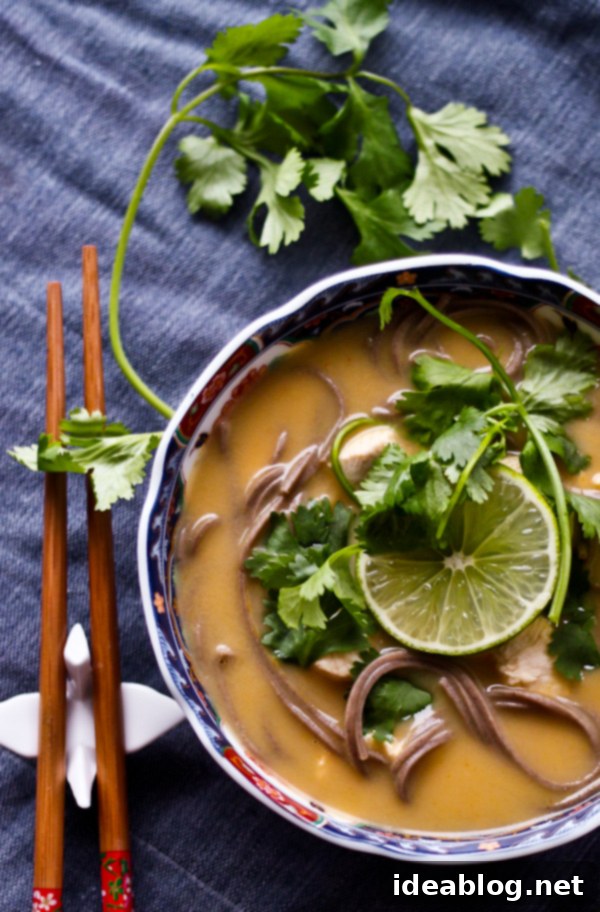
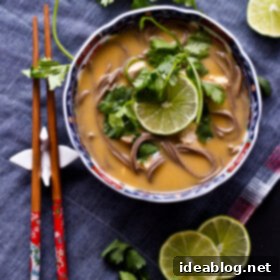
Thai Coconut Chicken Noodle Soup
Pin
Review
SaveSaved!
For the best results, source fresh kaffir lime leaves and dried (or even better, fresh!) galangal from Asian supermarkets or well-stocked specialty stores like Whole Foods.
Ingredients
- 2 quarts low-sodium chicken broth
- 4 ounces dried soba noodles
- 2 inch chunk fresh ginger peeled and roughly chopped
- 5 fresh kaffir lime leaves torn or gently bruised
- 2 teaspoons dried galangal root (or 1-inch fresh, thinly sliced)
- 1½ teaspoons Thai red curry paste
- 1 teaspoon fish sauce
- ⅛ teaspoon ground cayenne pepper (adjust to taste for heat)
- 1⅓ cups (320 mL) light canned coconut milk
- 1 (8 oz) large boneless chicken breast cut into ½-inch pieces
- ½ lime for juicing
- fresh lime wedges for serving
- cilantro leaves for garnish
Instructions
-
Prepare the Broth Base and Noodles: Begin by pouring the two quarts of low-sodium chicken broth into a large soup pot. Bring the broth to a rolling boil over high heat, then reduce the heat and allow it to simmer gently until the liquid has reduced by half. This reduction step is crucial as it concentrates the flavors, creating a more intense and delicious base for your soup. Meanwhile, in a separate large pot, bring a generous amount of water to a boil. Season this water generously with salt – just as you would for pasta – to properly season the noodles. Add the dried soba noodles and cook them according to package directions until they are perfectly al dente, meaning they are just firm to the bite. Once cooked, drain the noodles thoroughly and rinse them under cold water to prevent them from sticking together and to halt the cooking process. Set the rinsed noodles aside in a bowl.
-
Infuse the Aromatics: To the reduced chicken broth, add the roughly chopped ginger, torn kaffir lime leaves, and dried galangal root (or fresh, thinly sliced galangal). Reduce the heat to a very low simmer and allow these aromatics to infuse the broth for a full 15 minutes. This gentle simmering ensures that all the fragrant oils and flavors are slowly released into the liquid. For easier straining later, you can alternatively combine these ingredients in a cheesecloth sachet and tie it securely before adding it to the broth. After 15 minutes, carefully strain the infused broth into another clean large soup pot, discarding the spent aromatics. This step ensures a smooth broth free of fibrous bits. Return the strained, aromatic broth to the stovetop and taste it, seasoning with additional salt or pepper as needed to your preference.
-
Build the Creamy Flavor Profile: Into the warm, strained broth, whisk in the Thai red curry paste, fish sauce, and ground cayenne pepper (adjusting the amount of cayenne to your desired level of heat). Finally, stir in the light canned coconut milk until it is fully incorporated and the broth takes on a creamy, opaque appearance. Place the pot over very low heat – the goal is to keep it very hot but not to bring it to a boil, as boiling can cause the coconut milk to separate. Add the ½-inch pieces of boneless chicken breast to the simmering broth, stirring occasionally. Allow the chicken to cook gently until it is almost opaque and cooked through, but still very tender. Then, add the pre-cooked soba noodles to the pot, allowing them to warm through in the flavorful broth. Continue cooking just until the chicken is perfectly tender, typically only a few more minutes.
-
Final Touches and Serving: Just before serving, stir in the fresh juice of half a lime. This bright acidity will cut through the richness of the coconut milk and awaken all the flavors in the soup, providing a refreshing finish. Ladle the Thai Coconut Chicken Noodle Soup into individual bowls, ensuring each serving has a good balance of broth, chicken, and noodles. Serve piping hot, generously garnished with fresh cilantro leaves. Accompany each bowl with extra lime wedges for squeezing, allowing everyone to customize the level of citrusy tang in their soup. Enjoy this warming, aromatic, and deeply satisfying homemade Thai-inspired meal!
Tips for Success:
- Ingredient Sourcing: As mentioned, fresh kaffir lime leaves and fresh (or dried) galangal are highly recommended for the most authentic flavor. You can typically find these essential Thai aromatics at Asian supermarkets, specialty international grocery stores, or even some larger health food stores like Whole Foods. If using dried galangal, consider steeping it in a little warm water before adding to the broth to help rehydrate and release its flavors.
- Broth Reduction: Don’t skip the broth reduction step! It’s key to building a concentrated, flavorful base that isn’t watery. Reducing by half allows the chicken broth’s natural savory notes to intensify.
- Noodle Prep: Rinsing the soba noodles in cold water after cooking is important. This stops the cooking process, removes excess starch, and prevents them from clumping together, ensuring a pleasant texture in your soup. Add them at the very end to avoid them becoming mushy.
- Coconut Milk Care: When adding coconut milk, keep the heat low. High heat can cause the fat and liquid in the coconut milk to separate, resulting in an oily, curdled appearance. A gentle simmer is all you need.
- Adjusting Spice: The cayenne pepper adds a gentle heat. Feel free to increase or decrease the amount based on your personal preference for spiciness. You can also add fresh sliced Thai chilies for more intense heat.
- Taste and Adjust: Always taste your soup before serving. Thai cuisine is all about balancing flavors—sweet, sour, salty, and spicy. Adjust the fish sauce for saltiness, lime juice for sourness, and a pinch of sugar (not in this recipe, but a common Thai adjustment) if you feel it needs a touch of sweetness to round out the profile.
- Variations:
- Vegetables: Enhance your soup with various vegetables like sliced bell peppers, baby bok choy, mushrooms, bamboo shoots, or spinach. Add them during the last few minutes of cooking so they remain crisp-tender.
- Protein Alternatives: Instead of chicken, try shrimp, firm tofu (fried or baked before adding), or thinly sliced beef. Adjust cooking times accordingly.
- Noodle Options: While soba noodles are great, rice vermicelli, udon noodles, or even spiralized zucchini noodles (for a low-carb option) can be used.
